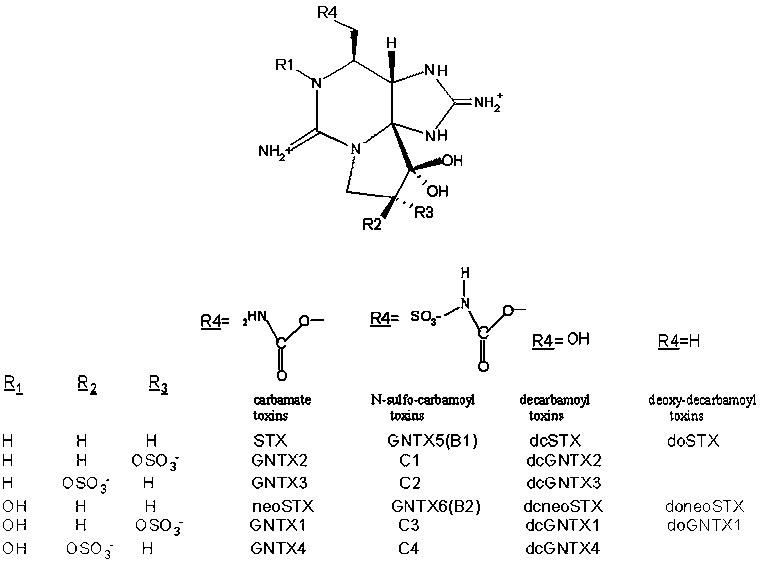The PSP toxins form a group of closely related tetrahydropurine compounds that make up four subgroups: i) carbamate (STX, neoSTX and gonyautoxins (GNTX1-4); ii) N-sulfo-carbamoyl (GNTX5-6, C1-4); iii) decarbamoyl (dc-) (dcSTX, dcneoSTX, dcGNTX1-4); and iv) deoxydecarbamoyl (do-) (doSTX, doneoSTX and doGNTX1) components. At least 21 PSP toxins (see Figure 2.1), mainly from marine dinoflagellates and shellfish that feed on toxic algae, have been identified. Attempts to isolate PSP toxins began more than one hundred years ago but their occurrence as mixtures of compounds with different ionizable functionalities complicated isolation procedures and early progress was slow. The development of ion-exchange chromatography, guided by mouse bioassays, eventually led to the isolation of a water-soluble basic toxin from the Alaska butterclam (Saxidomus giganteus). This compound was later given the trivial name saxitoxin (STX).
In 1975, the first crystalline derivative of STX was synthesized and the structure was studied (Bower et al., 1981). By means of x-ray crystallographic and nuclear magnetic resonance (NMR) spectroscopic studies the structure of STX was elucidated (see Figure 2.1 for the chemical structures of STX and other PSP toxins). The dihydroxy or hydrated ketone group on the five ring is essential for its poisonous activity. Catalytic reduction of this group with hydrogen to a monohydroxy group eliminates the activity. Removal of the carbamoyl group side-chain on the six-membered ring, leaving a hydroxyl group in its place, produces a molecule with about 60 percent of the original toxic activity. The presence of this active hydroxyl group establishes a means for the preparation of various derivatives of STX (Mons et al., 1998). The PSP toxins are heat stable at acidic pH (with the exception of the N-sulfo-carbamoyl components) but unstable and easily oxidized under alkaline conditions (Mons et al., 1998).
Figure 2.1 Chemical structures of PSP toxins

Source: Mons et al., 1998; Quilliam et al., 2001